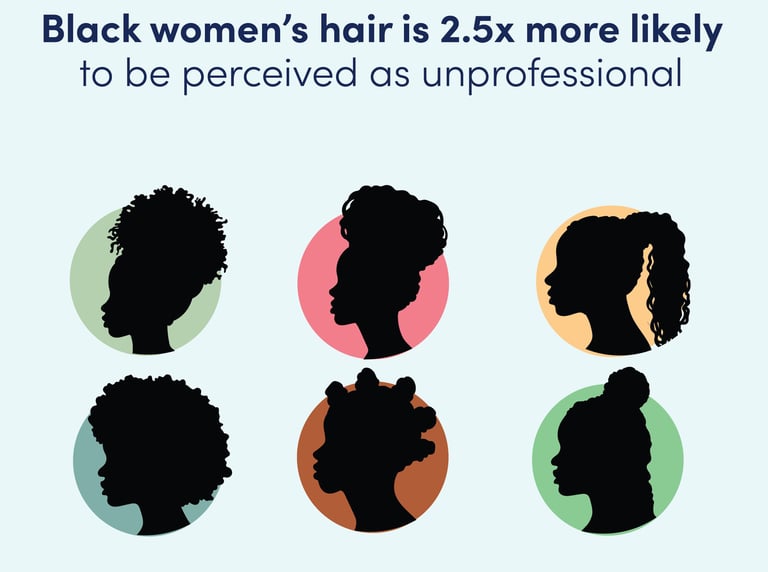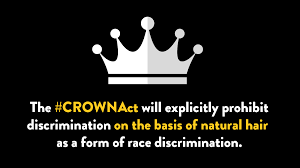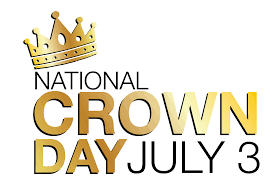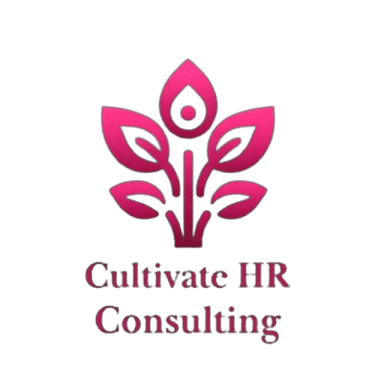Breaking the Bias: How the CROWN Act is Redefining Professionalism and Protecting Natural Hair in the Workplace
Blog post description.
9/22/20245 min read
The workplace should be a place where individuals are valued for their skills, talents, and contributions. However, for many Black employees, natural hair has been a source of bias and discrimination. Too often, hairstyles like braids, locs, bantu knots, afros, and natural curls are deemed “unprofessional,” forcing people to choose between their identity and career advancement. The CROWN Act was introduced and passed in several states to protect employees from race-based hair discrimination. This article explains what the CROWN Act is, why it’s essential, and how businesses can ensure compliance to create more inclusive workplaces.
What is the CROWN Act?
The CROWN Act stands for Creating a Respectful and Open World for Natural Hair. It is legislation that prohibits discrimination based on race-related hair textures and protective hairstyles, such as braids, twists, locs, and bantu knots, often worn by Black individuals.
Passed in California in 2019, the law has since been adopted by several other states and municipalities across the country including Wake County, Orange County, Durham County, and Charlotte, NC. The goal is to eliminate race-based hair discrimination in schools and workplaces, ensuring that people are not penalized, mistreated, or excluded because of their natural hair.
Why is the CROWN Act Important?
For decades, individuals with natural hair, particularly those of African descent, have faced unfair treatment in professional and educational environments due to hairstyles that don’t conform to Eurocentric beauty standards. Hair has been labeled “unprofessional,” “untidy,” or “inappropriate,” leading to lost job opportunities, disciplinary action in schools, and an overall sense of exclusion.
The CROWN Act is important because it addresses systemic racism that’s often overlooked. By prohibiting this form of discrimination, the law ensures that individuals can wear their natural hair without fear of being judged or treated unfairly, promoting a more inclusive and diverse environment in both schools and the workplace.
The Burden of "Covering"
As a Black woman with natural curls, I have experienced firsthand how organizations have created unwritten policies and practices that, intentionally or not, were biased against natural hairstyles like mine. Despite my education, experience, and skills, I have been in professional settings where I was told—either explicitly or through unspoken expectations—that my natural hair was not "professional enough." I've been questioned about my hair choices as if they were not my own to make. I have been starred at, talked about, made fun of, and even dismissed because of my "different" hairstyles.
When I learned about "covering," a term used to describe how people downplay or hide parts of their identity to fit into mainstream corporate culture, I knew I wasn't the only one who had experienced this. For many Black employees, including myself, this meant feeling pressure to straighten our hair or adopt styles that conform to traditional Eurocentric norms. This unspoken rule, which penalized Black hair textures and styles, sent a message that in order to be accepted in these "professional" settings, I had to disassociate from part of who I am.
I remember an incident early in my career when I was preparing for a presentation. My nerves were already high, but I was also conscious of the fact that my natural curls might not be seen as "polished" or "executive enough." Comments from colleagues suggesting I "change" my hair for the big meeting reinforced the idea that my natural state wasn’t good enough. I remember feeling frustrated that the comments were made. No one else was being asked about their hair. I was silently offended. I complained to my family and friends but I never said anything to these colleagues because I did not want to risk any blowback in the office. And this is an experience shared by many Black professionals who are forced to downplay their identity in order to fit into a work culture that doesn't fully embrace who they are.
This pressure to cover can be exhausting and damaging, leading employees to feel undervalued and unseen. For a long time, I believed that changing my appearance was necessary to advance my career. However, legislation like the CROWN Act is here to challenge those norms and ensure that no one has to hide their authentic selves to be accepted in the workplace.
What Businesses Need to Do to Incorporate the CROWN Act
For businesses, the CROWN Act is more than just another law to follow—it’s an opportunity to foster a culture of inclusivity and respect. Here are key steps you can take today:
Update Employee Handbooks and Policies: Review and revise your dress code and grooming policies to ensure they do not prohibit or discourage hairstyles that are protected under the CROWN Act. Policies should specifically allow for natural hair and protective styles like braids, locs, and twists.
Train Your Employees and Management: Conduct training sessions to educate your staff and leadership teams on the CROWN Act and the importance of respecting different hair textures and styles. Managers and HR professionals should be aware of what constitutes hair discrimination and how to address it.
Promote an Inclusive Workplace Culture: Encourage open conversations around race, hair, and identity. Creating a supportive environment where all employees feel comfortable being themselves—whether that involves natural hair or not—is critical to fostering diversity and inclusion.
Implement a Clear Grievance Process: Ensure there’s a formal process in place for employees to report incidents of any type of discrimination (including hair discrimination). Employees need to know that if they face such issues, the company will take immediate and effective action.
Monitor Compliance: Regularly review your company’s compliance with the CROWN Act. This can be done through internal audits, anonymous employee surveys, and consistent reviews of workplace culture to ensure that no one feels excluded or targeted due to their hair.
Best Practices for Businesses
Beyond legal compliance, businesses can take additional steps to support an environment that values all aspects of employee identity.
Celebrate Diversity in Grooming Choices: Highlight the beauty and diversity of all hair types through internal campaigns, discussions, or employee resource groups. Consider hosting a “Natural Hair Day” or featuring employees who wear protective styles in company communications.
Encourage Zero-Tolerance for Microaggressions: While overt discrimination may be rare, microaggressions around hair—such as inappropriate comments or unsolicited touching—can create a hostile environment. Make it clear that such behavior is not tolerated. Also, be sure to include reporting procedures in your policy and take employee complaints seriously.
Stay Updated on Laws in Your Area: The CROWN Act has been passed in several states and municipalities, and more are adopting similar legislation. Make sure you stay informed about the legal landscape where your business operates.
Why Employers Should Care About the CROWN Act
When businesses support the diversity of their employees, they foster an environment of respect, trust, and inclusion, which can lead to higher employee morale and productivity. Employees who feel accepted and valued are more likely to be engaged, motivated, and loyal to their employers. Additionally, companies need to reflect on the diversity of their practices, policies, and culture.
The CROWN Act is a crucial step in the fight against race-based discrimination. For employees, like myself, this law is personal. It represents the ability to show up authentically in the workplace without fear of judgment or repercussions. It is a reminder that talent, expertise, and professionalism should never be measured by how closely someone’s appearance aligns with traditional norms.
By creating a world where people can express themselves fully and authentically, without fear of discrimination, we’re moving one step closer to creating a workplace—and society—where everyone belongs.








